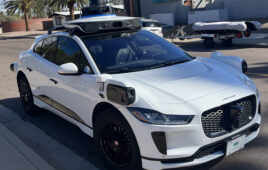 I recently spoke with Dr. Hamid Vejdani, an assistant professor in Mechanical Engineering department at Lawrence Technological University in suburban Detroit. Vejdani’s research interests include bioinspired robotics, behavior design and control design of robots, and dynamical modeling. Before joining LTU, he was a postdoctoral research associate at Brown University, where he studied dynamical agility of flapping flight in hummingbirds and bats.
I recently spoke with Dr. Hamid Vejdani, an assistant professor in Mechanical Engineering department at Lawrence Technological University in suburban Detroit. Vejdani’s research interests include bioinspired robotics, behavior design and control design of robots, and dynamical modeling. Before joining LTU, he was a postdoctoral research associate at Brown University, where he studied dynamical agility of flapping flight in hummingbirds and bats.
Vejdani has developed and implemented control strategies for walking and running bipedal robots and he has been exploring the mechanics of flapping flight systems inspired by stability, maneuverability and agility of natural fliers. We chatted about the main thrust of his research in robotics, “Bio-inspiration.” This concept means getting inspiration from nature and applying the lessons learned into designing and controlling capable engineering products and, in his research, robots.
DW: Biomimicry receives a lot of press, especially in the robotics field. You’ve said you’re more focused on bio-inspired designs. How do these two approaches differ?
HV: Basically, in biomimicry you try to mimic nature as close as possible. Although it is a fantastic way to start, it will not be that helpful when you want to expand the findings to other scales or purposes. In bioinspired designs, we try to understand the fundamental physics behind the phenomena (which can sometimes start with mimicking in the beginning) and therefore those principles can be expanded and used for any scale or application because the laws of physics. Once you understand them and apply them appropriately, they are the same for all of our engineering products.
DW: What are some examples of bio-inspired designs that you are working on?
HV: I am currently working on two bio-inspired robotics projects here at Lawrence Technological University. One is inspired by agility and maneuverability of kangaroo running (a kangaroo running robot) and the other is inspired by the efficiency and stability of hummingbird hovering (hummingbird-scale hovering robot).
Although it seems diverse in the first glance — running and flying — when you study the principles of animal locomotion in more detail, you notice that there is a common trace in all animal locomotion types. That is the use of their natural dynamics (mechanical design of the system) in providing help to achieve the desired motion. My research is to understand how these natural dynamical characteristics — like mass distribution and sizes — can be used to enhance the stability and maneuverability of locomotion in each case.
DW: Do you see practical applications of bio-inspired design for industry? What are some examples?
HV: Basically, the industry (and in a broader sense engineering) is full of bio-inspired design products and ideas from architectural designs and materials for cooling and force resistance to airspace industry and defense. For example, look at airplanes; we do not mimic the wings from birds, we found out that wings and tails are necessary for flight. Now we have airplanes that are basically fixed winged vehicles, in contrary to natural fliers, which have flapping wings. So, we got inspired from nature and developed the airplane industry.
I think the robotics industry will continue to grow much faster in developing robots that can get outside of the structured labs and help human in real world. And guess who can be the source of the inspiration for designing such machines? Probably those who have been operating in real world for millions of years: animals.
DW: What’s your strategy for teaching college engineering students about robotics? How or where does bio-inspired design fit in? Do you find that gives students a better touch point?
HV: My strategy is to connect the robotics concepts to something tangible for students, be their experience of driving a car or running on the beach. If the students can visualize the implementation of those concepts into some familiar phenomena that they have observed or experienced, then they can see the value behind understanding the concepts. It is not a surprise that humans are mesmerized by nature — and that is what I use as the hook to interest students when I am teaching robotics. Fortunately in robotics, you nearly always can find some good connections, from the human hand for industrial robots to birds for aerial robots.
DW: Let’s talk a bit about today’s college engineering programs. Are they different than they were a generation ago? How have they improved or changed? What is the biggest challenge today in preparing students for jobs in industry?
HV: We absolutely have had big changes in college engineering programs, based on the growth in technology and the needs in engineering world. In the past, students basically needed to learn the skills to be able to apply them to solve problems when they graduate. Nowadays, specific skills may even become outdated by the time the students graduate or there might be a new software or AI that can deliver those tasks.
Therefore, we need to make our students adaptable to the fast-paced growth of technology. I believe beside teaching them the fundamental principles, we need to train them to think outside of the box, be team players and become efficient self-educators. We need to update our teaching methods and probably the biggest challenge for university professors is to update the way we all learned the engineering concepts which was mainly lecture based. It definitely needs us to come from outside of our comfort zone.
DW: Do you have any thoughts on how we can better interest young girls in engineering careers such as robotics? What are we doing right and where can we do better?
HV: We need to find the motivational points for our targets to interest them. I think women in general care a lot about helping others. If we inform society that robotics is not all about building industrial robots that are used in production lines, but also in robotics we can design and build prosthetics and exoskeleton to help disabled people, that’s a positive. Similarly, robots can help elderly people or robots can be used in rehabilitation, which directly improve the quality of lives for millions. Here, we can get their attention even more.
I think establishing direct communication between high schools and maybe even middle schools with universities can be really helpful, because the main source of the impression for robotics nowadays is through movies — that, in many cases, is far from reality and not helpful.
You may also like:
Filed Under: Commentaries • insights • Technical thinking, Robotics • robotic grippers • end effectors








